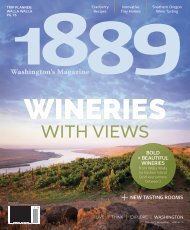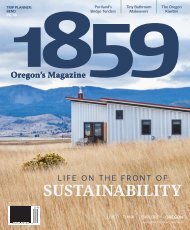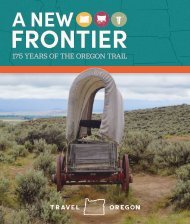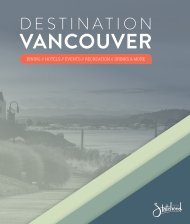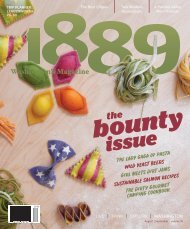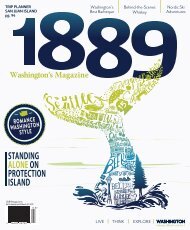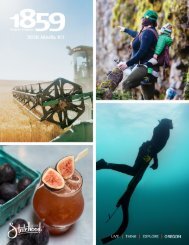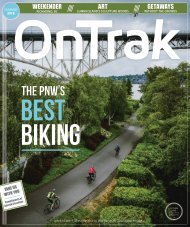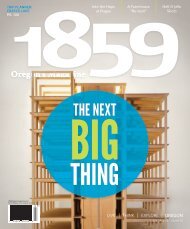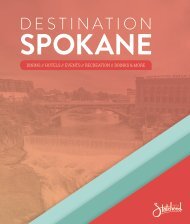Create successful ePaper yourself
Turn your PDF publications into a flip-book with our unique Google optimized e-Paper software.
Jeremy Faber, of Foraged and Found Edibles, scouts for mushrooms. The company supplies wild mushrooms, greens, berries and teas<br />
to hundreds of restaurants and markets around the country.<br />
He started this practice during an especially<br />
fruitful porcini year—soon he was delivering the<br />
surplus to chefs around town. He and his team<br />
believe in the culinary and medicinal benefits of<br />
this bounty. They don’t aim to be the first with<br />
each season’s forage. Instead, they wait for the<br />
right time to harvest so customers can receive<br />
the best and freshest.<br />
Mushrooms grow all over Washington, but<br />
their abundance depends on the season, the<br />
weather, that year’s snowpack, heat, rainfall and<br />
other environmental factors. Highly popular<br />
morels, for example, grow well the year after<br />
wildfires, so foragers covet affected regions.<br />
“It takes a lot of being in the woods, on the<br />
ground, scouting out patches of mushrooms and<br />
remembering for the following year," Augustine<br />
said. Chanterelles typically pop up around Mount<br />
Rainier in the summer and coastal Washington<br />
as summer progresses, while lobster mushrooms<br />
also thrive around Rainier. Foraging can consist<br />
of long days with early start times, miles-long<br />
hikes into the wilderness and overnight camping.<br />
Until recently relocating to a Georgetown<br />
space, Foraged and Found ran its Seattle<br />
warehouse out of Faber’s Phinney Ridge<br />
basement, which Augustine described as<br />
“smelling like a giant mushroom … the scent<br />
of Earth.” The expansion of the business means<br />
a deepening of cooperation with Lao and<br />
Cambodian foraging families, with whom the<br />
company has a long-standing relationship.<br />
Foraged and Found’s consistently popular items<br />
include morels and chanterelles, “the bread-and-<br />
butter” mushroom that every chef wants on the<br />
menu, plus stinging nettles in the spring and<br />
huckleberries in late summer. “[Faber] is always<br />
trying to add something new to the list—it’s very<br />
important to him,” Augustine said.<br />
Faber insists on sourcing indigenous goods<br />
whenever possible. Products are harvested solely<br />
in North America, with a focus on the Pacific<br />
Northwest. After expanding the business to New<br />
York and Boston, however, Forage and Found has<br />
also begun harvesting regionally in the Northeast.<br />
Loyal Seattle customers include James Beard<br />
Foundation Award-winning chefs Matt Dillon,<br />
Tom Douglas, Jerry Traunfeld and James Beardnominated<br />
Ethan Stowell. In addition to these<br />
restaurants, Foraged and Found’s bounty can<br />
be sampled at Seattle venues such as Spinasse,<br />
Altura, Copine and Harvest Beat. (In New York,<br />
clients include Gramercy Tavern, Daniel and<br />
Le Bernardin.)<br />
Augustine points those interested in foraging<br />
toward the Puget Sound Mycological Society<br />
(“one of the best in the country” for educational<br />
talks and fields trips). “Forage for wild edibles<br />
with caution, and learn from an experienced<br />
harvester,” Cascadia Mushrooms' Winstead<br />
advised. “The time you take to learn about and<br />
gather the wild foods growing in this region will<br />
bring you closer to the heart of our home.”<br />
Week after week in farmers markets,<br />
Augustine divines an emerging trend. “There’s<br />
a certain mysticism surrounding foraging. …<br />
I think there’s a real hunger for people to find<br />
that again.”<br />
28 <strong>1889</strong> WASHINGTON’S MAGAZINE AUGUST | SEPTEMBER <strong>2017</strong>




